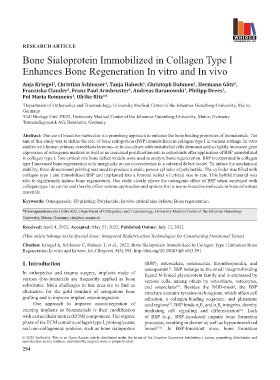Page 262 - IJB-8-3
P. 262
RESEARCH ARTICLE
Bone Sialoprotein Immobilized in Collagen Type I
Enhances Bone Regeneration In vitro and In vivo
Anja Kriegel , Christian Schlosser , Tanja Habeck , Christoph Dahmen , Hermann Götz ,
1
2
1
1
1
Franziska Clauder , Franz Paul Armbruster , Andreas Baranowski , Philipp Drees ,
1
1
3
3
Pol Maria Rommens , Ulrike Ritz *
1
1
1 Department of Orthopedics and Traumatology, University Medical Center of the Johannes Gutenberg-University, Mainz,
Germany
2 Cell Biology Unit, PKZI, University Medical Center of the Johannes Gutenberg-University, Mainz, Germany
3 Immundiagnostik AG, Bensheim, Germany
Abstract: The use of bioactive molecules is a promising approach to enhance the bone healing properties of biomaterials. The
aim of this study was to define the role of bone sialoprotein (BSP) immobilized in collagen type I in various settings. In vitro
studies with human primary osteoblasts in mono- or in co-culture with endothelial cells demonstrated a slightly increased gene
expression of osteogenic markers as well as an increased proliferation rate in osteoblasts after application of BSP immobilized
in collagen type I. Two critical size bone defect models were used to analyze bone regeneration. BSP incorporated in collagen
type I increased bone regeneration only marginally at one concentration in a calvarial defect model. To induce the mechanical
stability, three-dimensional printing was used to produce a stable porous cylinder of polylactide. The cylinder was filled with
collagen type I and immobilized BSP and implanted into a femoral defect of critical size in rats. This hybrid material was
able to significantly induce bone regeneration. Our study clearly shows the osteogenic effect of BSP when combined with
collagen type I as carrier and thereby offers various approaches and options for its use as bioactive molecule in bone substitute
materials.
Keywords: Osteogenesis; 3D printing; Polylactide; In vivo critical size defects; Bone regeneration
*Correspondence to: Ulrike Ritz, Department of Orthopedics and Traumatology, University Medical Center of the Johannes Gutenberg-
University, Mainz, Germany; ritz@uni-mainz.de
Received: April 4, 2022; Accepted: May 23, 2022; Published Online: July 12, 2022
(This article belongs to the Special Issue: Integrated Biofabrication Technologies for Constructing Functional Tissue)
Citation: Kriegel A, Schlosser C, Habeck T, et al., 2022, Bone Sialoprotein Immobilized in Collagen Type I Enhances Bone
Regeneration In vitro and In vivo. Int J Bioprint, 8(3):591. http://doi.org/10.18063/ijb.v8i3.591
1. Introduction (BSP), osteocalcin, osteonectin, thrombospondin, and
osteopontin . BSP belongs to the small integrin-binding
[1]
In orthopedics and trauma surgery, implants made of ligand N-linked glycoprotein family and is expressed by
various (bio-)materials are frequently applied as bone various cells, among others by osteoblasts, osteocytes,
substitutes. Main challenges in this area are to find an and osteoclasts . Besides the RGD-motif, the BSP
[2]
alternative for the gold standard of autogenous bone structure contains tyrosine-rich regions, which affect cell
grafting and to improve implant osseointegration. adhesion, a collagen-binding sequence, and glutamine
One approach to improve osseointegration of acid regions . BSP binds α ß and α ß integrins, thereby
[3]
v 5
v 3
existing implants or biomaterials is their modification mediating cell signaling and differentiation . Lack
[4]
with extracellular matrix (ECM) components. The organic of BSP (e.g., BSP-knockout) impairs bone formation
phase of the ECM contains collagen type I, proteoglycans, processes, resulting in shorter as well as hypomineralized
and non-collagenous proteins, such as bone sialoprotein bones [5-8] . In BSP-knockout mice, bone formation
© 2022 Author(s). This is an Open-Access article distributed under the terms of the Creative Commons Attribution License, permitting distribution and
reproduction in any medium, provided the original work is properly cited.
254

